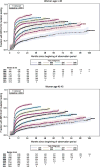Rates of BRCA1/2 mutation testing among young survivors of breast cancer
- PMID: 26706041
- PMCID: PMC5521172
- DOI: 10.1007/s10549-015-3658-y
Rates of BRCA1/2 mutation testing among young survivors of breast cancer
Erratum in
-
Erratum to: Rates of BRCA1/2 mutation testing among young survivors of breast cancer.Breast Cancer Res Treat. 2016 Aug;159(1):201. doi: 10.1007/s10549-016-3922-9. Breast Cancer Res Treat. 2016. PMID: 27464794 No abstract available.
Abstract
Guidelines in the United States recommend consideration of testing for mutations in the BRCA1 and BRCA2 genes for women diagnosed with breast cancer under age 45. Identification of mutations among survivors has implications for secondary prevention and familial risk reduction. Although only 10 % of breast cancers are diagnosed under age 45, there are approximately 2.8 million breast cancer survivors in the United States, such that the young survivor population likely numbers in the hundreds of thousands. However, little is known about genetic testing rates in this population. We assessed trends in BRCA1/2 testing among breast cancer survivors who were under age 45 at diagnosis and were treated from 2005 to 2012. Using insurance claims from a national database (MarketScan), we identified incident breast cancer cases among (1) women aged ≤40 and (2) women aged 41-45. We measured BRCA1/2 testing using Kaplan-Meier analysis and Cox proportional hazards models. Among 26,985 patients analyzed, BRCA1/2 testing rates increased with each year of diagnosis from 2005 to 2012 (P < 0.001). However, among women treated in earlier years, testing rates did not approach those of patients treated later, even after extended follow-up (median time from surgery to testing among patients treated in 2005, not reached; median time to testing among patients treated in 2012, 0.2 months for women aged ≤40 and 1.0 month for women aged 41-45). Women aged 41-45 had lower rates than women aged ≤40 throughout the analysis period (P < 0.001 for each year). BRCA1/2 testing rates among young women with incident breast cancer increased substantially in the last decade. However, most survivors treated in earlier years have never been tested. Our results demonstrate a need to better incorporate genetic counseling into survivorship and primary care for this population.
Keywords: BRCA1; BRCA2; Breast cancer genetics; Health services research.
Conflict of interest statement
Conflict of Interest:
Kenneth L. Kehl declares that he has no conflict of interest. Chan Shen declares that she has no conflict of interest. Jennifer K. Litton declares that she has no conflict of interest. Banu Arun declares that she has no conflict of interest. Sharon H. Giordano declares that she has no conflict of interest.
Figures

Similar articles
-
Long-term outcomes of breast cancer in women aged 30 years or younger, based on family history, pathology and BRCA1/BRCA2/TP53 status.Br J Cancer. 2010 Mar 30;102(7):1091-8. doi: 10.1038/sj.bjc.6605606. Epub 2010 Mar 16. Br J Cancer. 2010. PMID: 20234365 Free PMC article.
-
Long-term prospective clinical follow-up after BRCA1/2 presymptomatic testing: BRCA2 risks higher than in adjusted retrospective studies.J Med Genet. 2014 Sep;51(9):573-80. doi: 10.1136/jmedgenet-2014-102336. Epub 2014 Jul 22. J Med Genet. 2014. PMID: 25053764
-
Use of genetic testing and prophylactic mastectomy and oophorectomy in women with breast or ovarian cancer from families with a BRCA1 or BRCA2 mutation.J Clin Oncol. 2003 May 1;21(9):1675-81. doi: 10.1200/JCO.2003.09.052. J Clin Oncol. 2003. PMID: 12721241
-
Risk Assessment, Genetic Counseling, and Genetic Testing for BRCA-Related Cancer in Women: Updated Evidence Report and Systematic Review for the US Preventive Services Task Force.JAMA. 2019 Aug 20;322(7):666-685. doi: 10.1001/jama.2019.8430. JAMA. 2019. PMID: 31429902
-
Breast cancer and ovarian cancer genetics.J Long Term Eff Med Implants. 2005;15(5):533-45. doi: 10.1615/jlongtermeffmedimplants.v15.i5.60. J Long Term Eff Med Implants. 2005. PMID: 16218901 Review.
Cited by
-
Information and support needs of young women regarding breast cancer risk and genetic testing: adapting effective interventions for a novel population.Fam Cancer. 2018 Jul;17(3):351-360. doi: 10.1007/s10689-017-0059-x. Fam Cancer. 2018. PMID: 29124494 Free PMC article.
-
Trends in BRCA Test Utilization in an Integrated Health System, 2005-2015.J Natl Cancer Inst. 2019 Aug 1;111(8):795-802. doi: 10.1093/jnci/djz008. J Natl Cancer Inst. 2019. PMID: 30753636 Free PMC article.
-
Efficacy versus effectiveness of clinical genetic testing criteria for BRCA1 and BRCA2 hereditary mutations in incident breast cancer.Fam Cancer. 2017 Apr;16(2):187-193. doi: 10.1007/s10689-016-9953-x. Fam Cancer. 2017. PMID: 28120249 Free PMC article.
-
Variations in the Referral Pattern for Genetic Counseling of Patients with Early-Onset Breast Cancer: A Population-Based Study in Southern Sweden.Public Health Genomics. 2020;23(3-4):100-109. doi: 10.1159/000508684. Epub 2020 Jul 8. Public Health Genomics. 2020. PMID: 32640451 Free PMC article.
-
Persistent Underutilization of BRCA1/2 Testing Suggest the Need for New Approaches to Genetic Testing Delivery.J Natl Cancer Inst. 2019 Aug 1;111(8):751-753. doi: 10.1093/jnci/djz009. J Natl Cancer Inst. 2019. PMID: 30753664 Free PMC article. No abstract available.
References
-
- National Comprehensive Cancer Network. Genetic/Familial High-Risk Screening: Breast. 2001 Version 1.
-
- National Comprehensive Cancer Network. Genetic/Familial High-Risk Assessment: Breast and Ovarian. 2005 Version 1.
Publication types
MeSH terms
Grants and funding
LinkOut - more resources
Full Text Sources
Other Literature Sources
Medical
Miscellaneous

